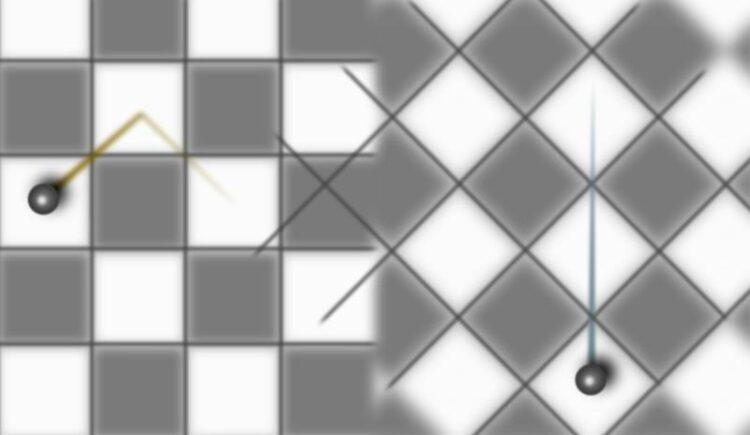Precise control of colloids through magnetism possible

Visualisation of magnetic controlled colloids
Bild: priv. / UBT
Bayreuth researchers have found ways to control tiny particles in liquids using magnetic patterns. The research results have now been published in the renowned journal „Nature Communications“ under the title „Simultaneous and independent topological control of identical microparticles in non-periodic energy landscapes“. Overall, the simultaneous and independent transport of colloidal particles over magnetic patterns can be of great use in various fields of science and technology to produce customised materials, improve biomedical applications, perform laboratory tests or investigate fundamental scientific questions.
In this theoretical and experimental work, Nico C.X. Stuhlmüller and Prof Dr Daniel de las Heras (theory) together with Farzaneh Farrokhzad and Prof Dr Thomas Fischer (experiments) investigated the simultaneous and independent transport of identical colloidal particles (nano- to micrometre-sized particles suspended in a liquid) over magnetic patterns.

From left to right: Daniel de las Heras, Nico C.X. Stuhlmüller, Farzaneh Farrokhzad and Thomas Fischer. Foto: priv. / UBT
External fields, such as electric and magnetic fields, are often used to transport a collection of colloidal particles. Identical particles are then transported along the same direction under the influence of the field. The scientists demonstrate here that using non-periodic energy landscapes it is possible to precisely control the transport of a collection of identical colloidal particles simultaneously and independently.
Magnetic microparticles are placed above a magnetic pattern. The pattern is made with up- and down-magnetized regions arranged differently depending on the position over the pattern. The transport is then driven by modulation loops of the orientation of an external magnetic field. A complex time-dependent and non-periodic energy landscape emerges due to the coupling between the external magnetic field and the field created by the pattern. Arbitrarily complex and tailored trajectories of several identical colloidal particles can be simultaneously encoded in either the pattern or the modulation loops. As an illustration, the scientists show how identical colloidal particles under the influence of the same modulation loop can write the first eighteen letters of the alphabet.
Beyond its fundamental interest, this work opens new routes to reconfigurable self-assembly in colloidal science and has potential applications in multifunctional lab-on-a-chip devices. A precise and simultaneous targeted control of colloidal particles using magnetic fields can be used for example to develop microfluidic systems that transport particles for laboratory testing and medical diagnosis.
The findings are the result of a collaboration between the University of Bayreuth, the University of Kassel and the Polish Academy of Sciences.
Wissenschaftliche Ansprechpartner:
Prof Dr Daniel de las Heras
Theoretical Physics
Phone: +49 (0) 921 55 33 46
Mail: daniel.de-las-heras@uni-bayreuth.de
Website: https//danieldelasheras.com
Originalpublikation:
Stuhlmüller, N.C.X., Farrokhzad, F., Kuświk, P. et al. Simultaneous and independent topological control of identical microparticles in non-periodic energy landscapes. Nat. Commun. 14, 7517 (2023).
DOI: https://doi.org/10.1038/s41467-023-43390-0
https://www.uni-bayreuth.de/en/presse-release/precise-control-colloids-magnetism
Media Contact
All latest news from the category: Life Sciences and Chemistry
Articles and reports from the Life Sciences and chemistry area deal with applied and basic research into modern biology, chemistry and human medicine.
Valuable information can be found on a range of life sciences fields including bacteriology, biochemistry, bionics, bioinformatics, biophysics, biotechnology, genetics, geobotany, human biology, marine biology, microbiology, molecular biology, cellular biology, zoology, bioinorganic chemistry, microchemistry and environmental chemistry.
Newest articles

A ‘language’ for ML models to predict nanopore properties
A large number of 2D materials like graphene can have nanopores – small holes formed by missing atoms through which foreign substances can pass. The properties of these nanopores dictate many…

Clinically validated, wearable ultrasound patch
… for continuous blood pressure monitoring. A team of researchers at the University of California San Diego has developed a new and improved wearable ultrasound patch for continuous and noninvasive…

A new puzzle piece for string theory research
Dr. Ksenia Fedosova from the Cluster of Excellence Mathematics Münster, along with an international research team, has proven a conjecture in string theory that physicists had proposed regarding certain equations….



